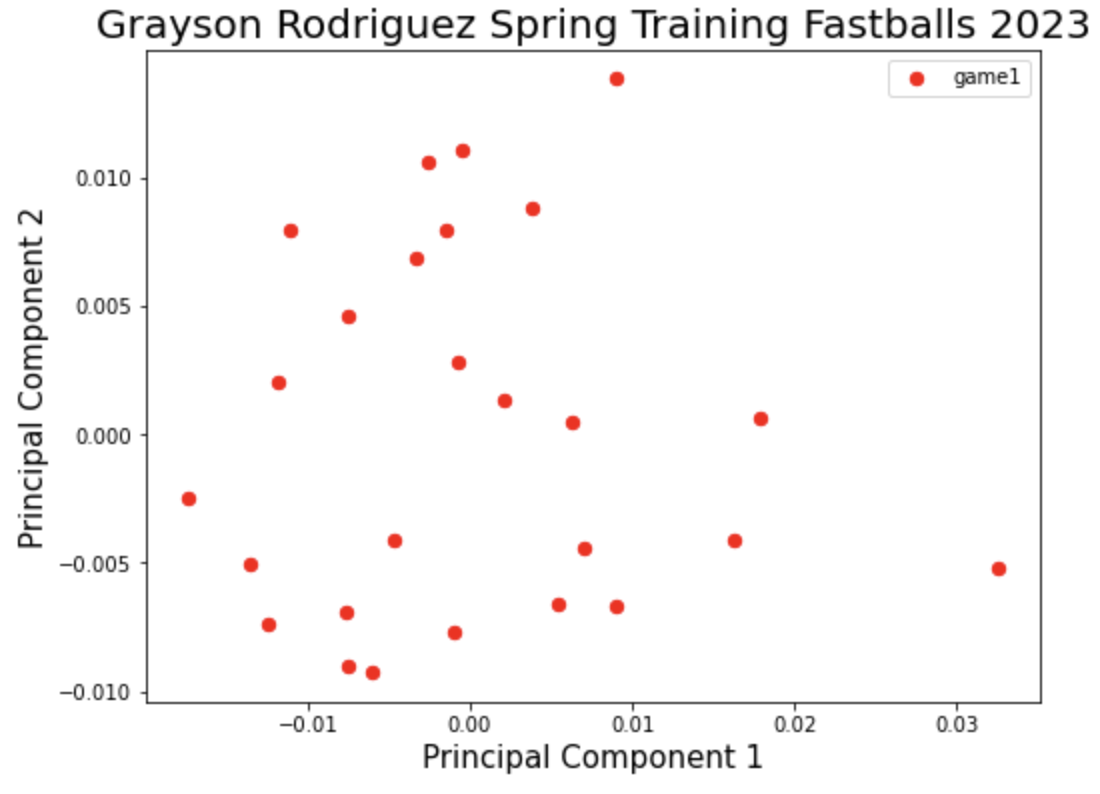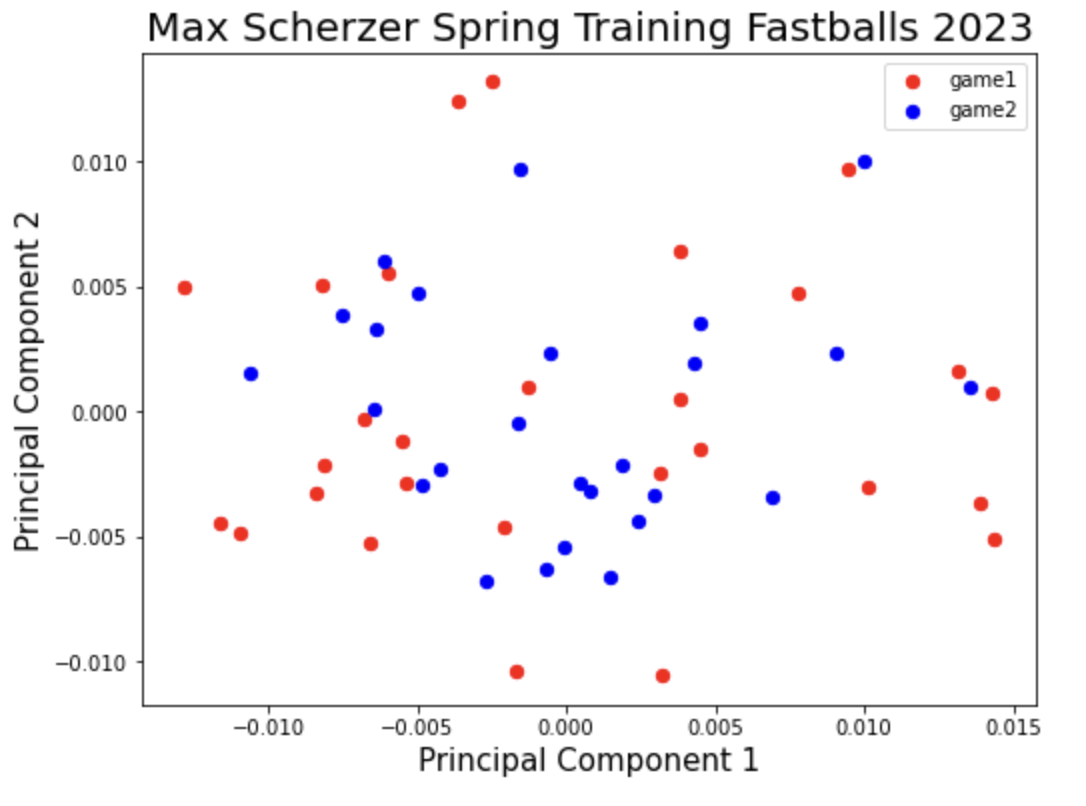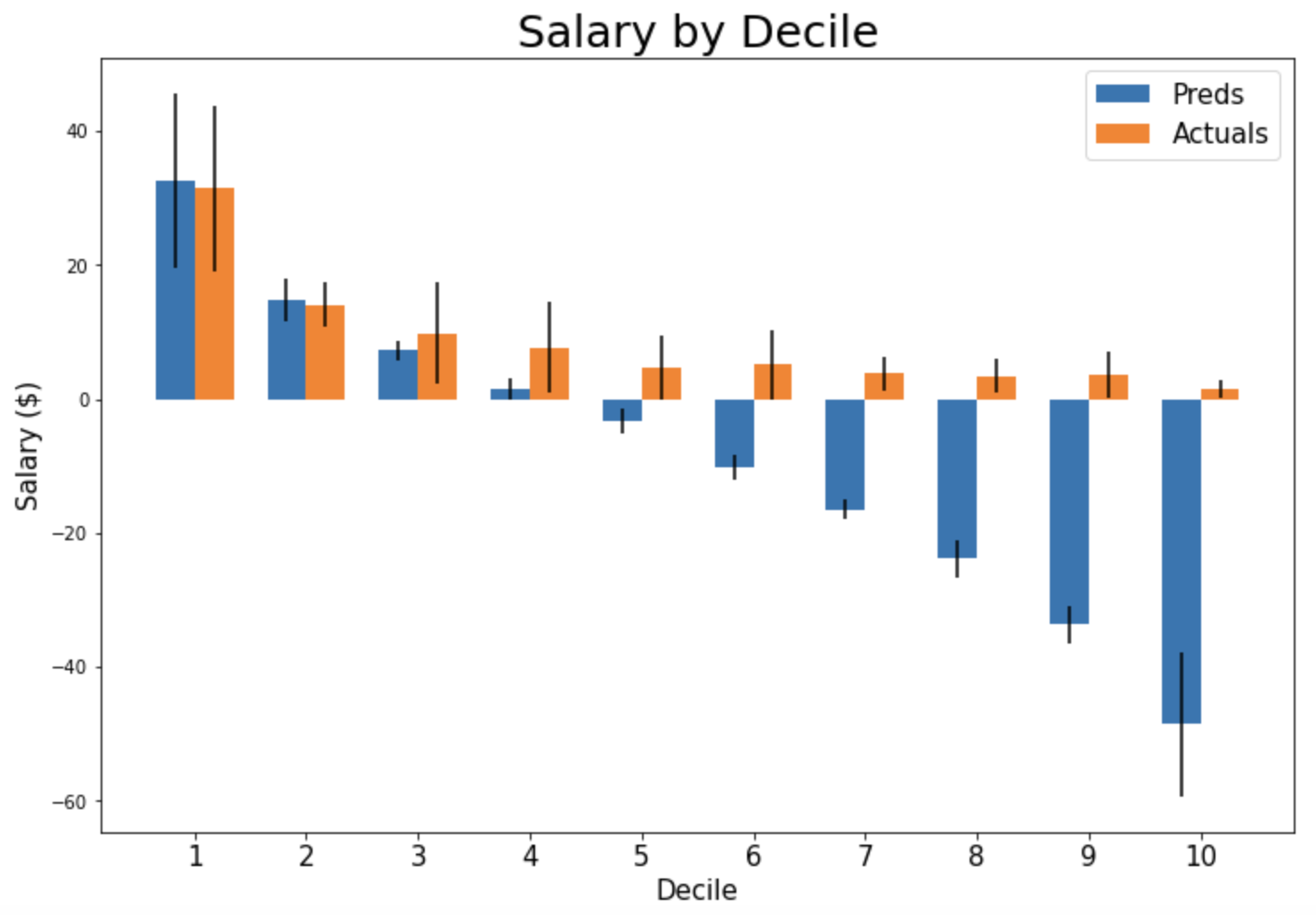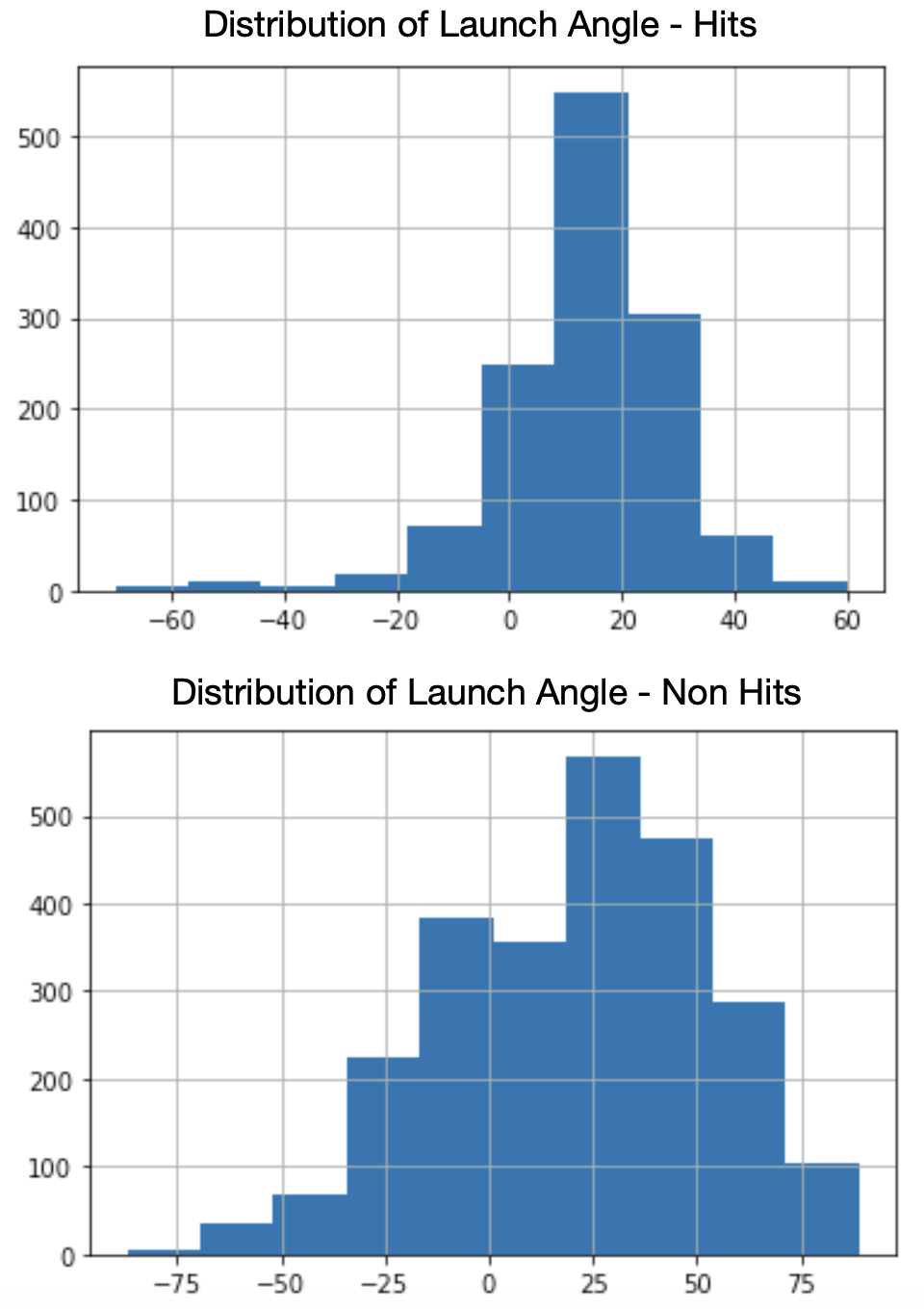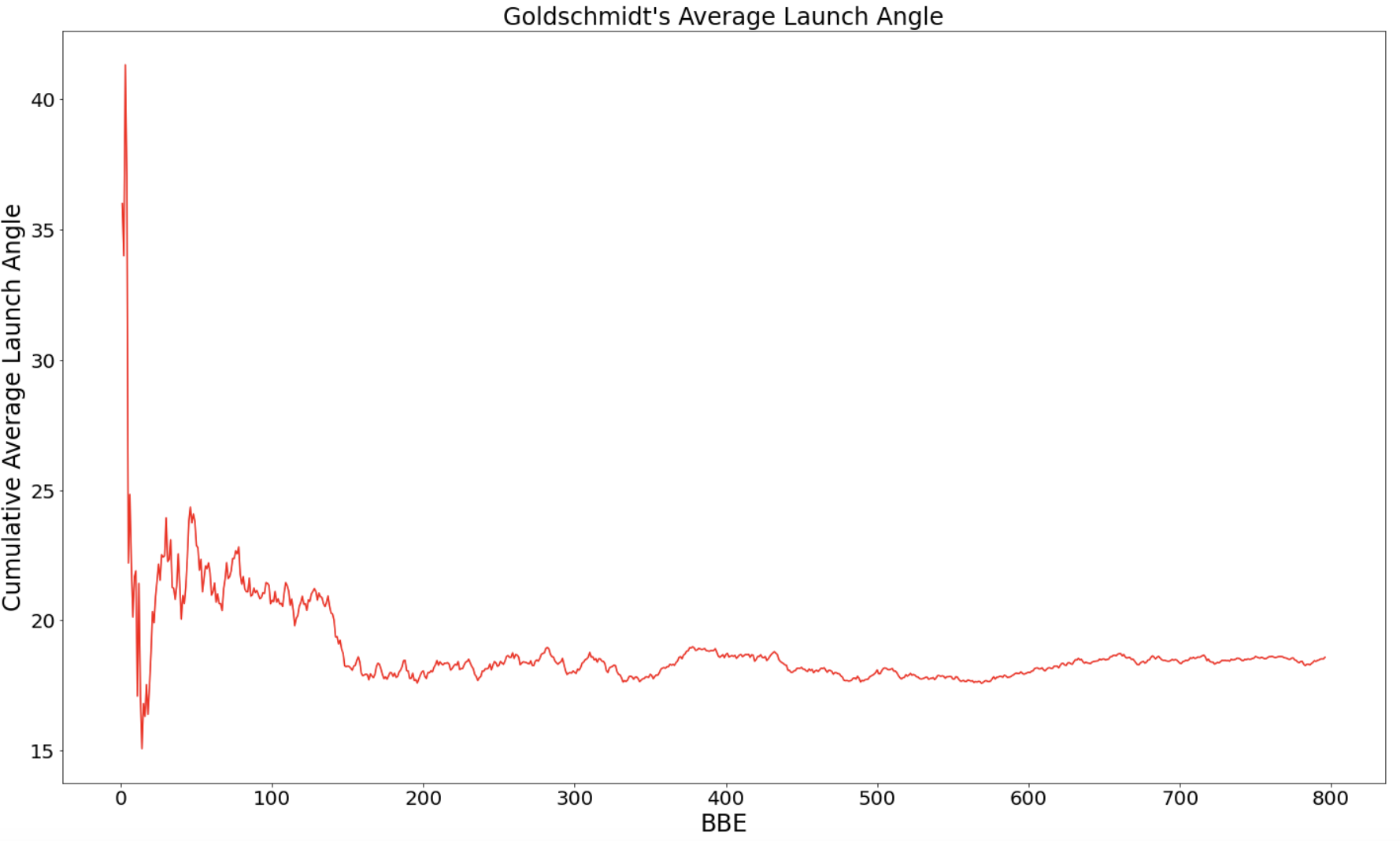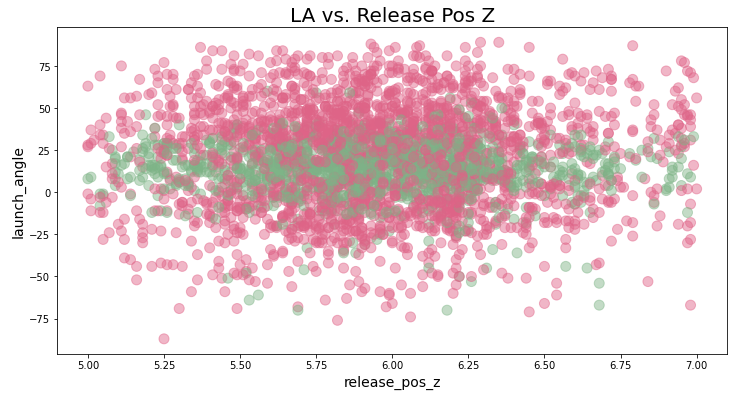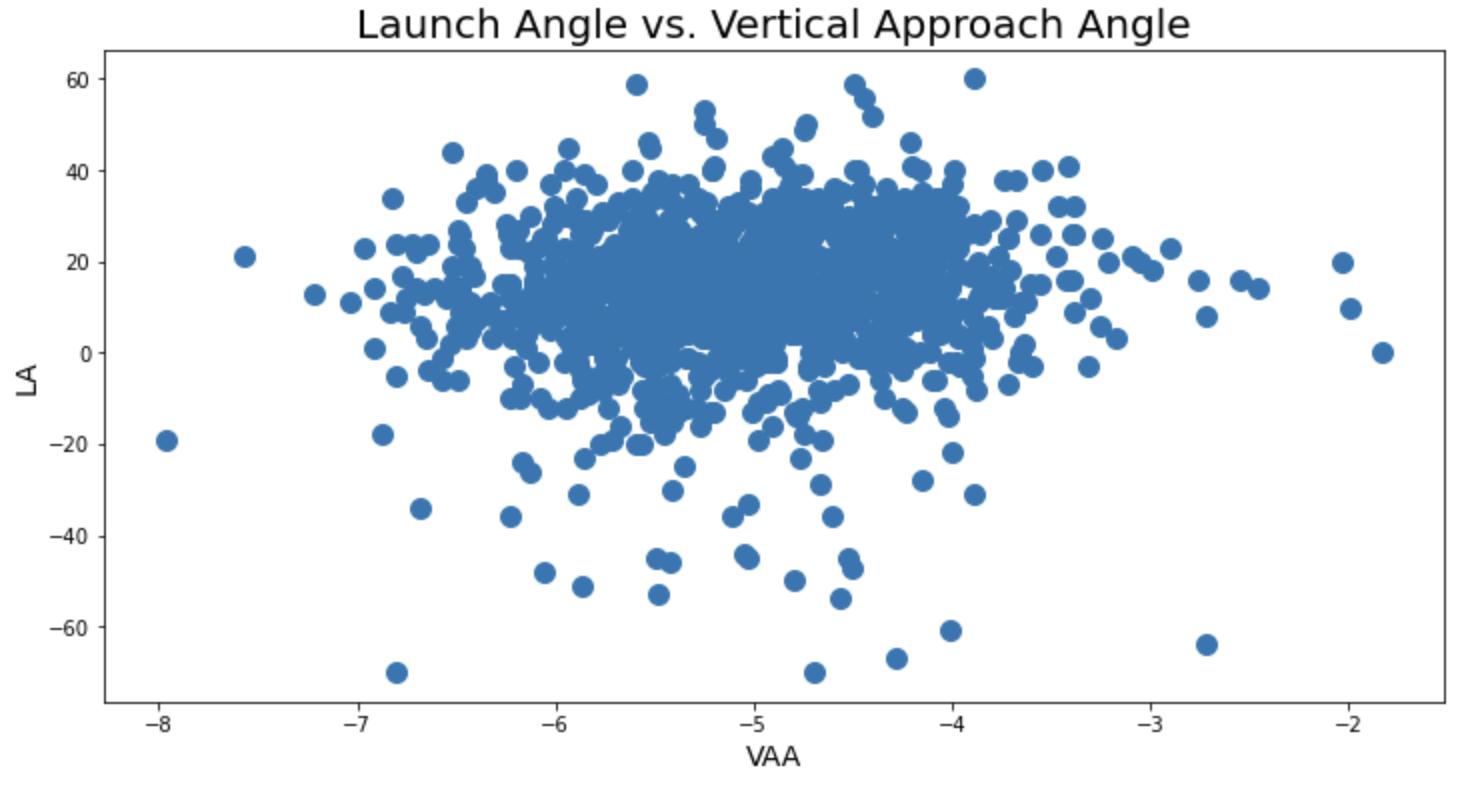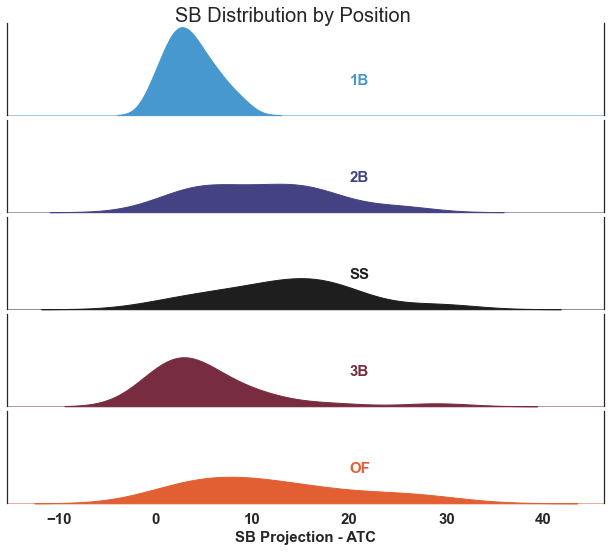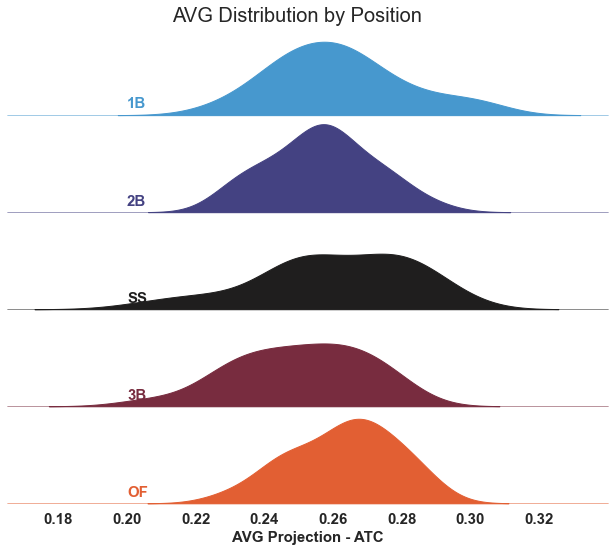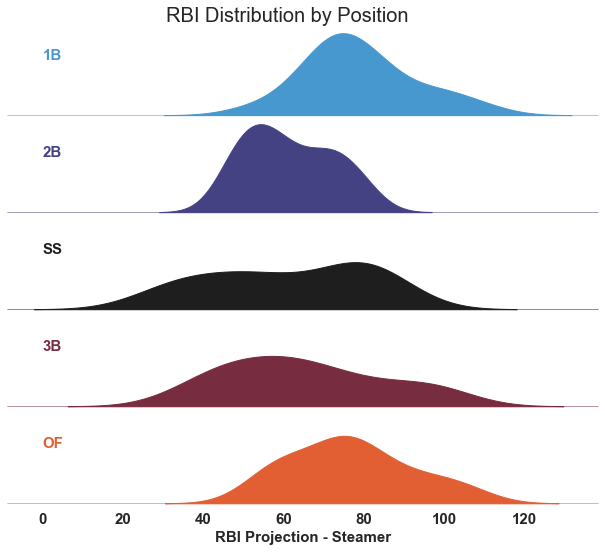Do you remember being a kid and really wanting a swiss-army knife? They were always locked up in a case, out of reach of 10-year-old grips which would happily test the product right there in the store if the guy with the keys would let them. The swiss-army knife could do it all and would turn any youngster into an adventuring hero instantly. But next to the super utility red magic instrument were the scarier single-blade knives that you were sure, positive, your mom would say no to. In fact, you weren’t so sure yourself if you could handle such an object. If fantasy baseball players on draft day are knives spinning in the display case at your local hardware store, ATC’s IntraSD provides instructions on how to use each one.
Spend a moment sorting by IntraSD on the ATC projections page and you’ll quickly understand what the metric seeks to explain. Players like Seiya Suzuki and Fernando Tatis Jr. have very low values and represent your swiss-army all-around player. Players like Pete Alonso and Jake McCarthy have high values and represent your scary, yet very sharp and useful, single-blade knives or category-specific players. IntraSD, in essence, measures how equally, or unequally, distributed a player’s roto category values are. Here are our four examples in both roto-values as created by z-scores on our auction calculator and the raw projections that generate those values:
Auction Calculator Category Values
| Name |
PA |
mAVG |
mRBI |
mR |
mSB |
mHR |
| Fernando Tatis |
502 |
$2.84 |
$1.88 |
$1.41 |
$5.07 |
$4.26 |
| Seiya Suzuki |
567 |
-$0.19 |
-$2.15 |
-$2.01 |
$0.85 |
-$1.38 |
| Pete Alonso |
657 |
$0.35 |
$10.71 |
$3.82 |
-$2.52 |
$8.55 |
| Jake McCarthy |
556 |
-$0.32 |
-$5.50 |
-$2.58 |
$9.82 |
-$6.51 |
*ATC projections, **Auction Calculator default settings, ***Yellow=LowIntra, Red=HighIntra
–
ATC Projections
| Name |
Team |
G |
PA |
AB |
HR |
R |
RBI |
SB |
AVG |
| Fernando Tatis Jr. |
SDP |
117 |
502 |
441 |
31 |
82 |
82 |
20 |
0.277 |
| Seiya Suzuki |
CHC |
135 |
567 |
497 |
20 |
73 |
69 |
11 |
0.262 |
| Pete Alonso |
NYM |
154 |
657 |
573 |
38 |
89 |
110 |
4 |
0.264 |
| Jake McCarthy |
ARI |
137 |
556 |
501 |
11 |
71 |
58 |
30 |
0.262 |
*Yellow=LowIntra, Red=HighIntra
My favorite way to approach a draft is to target the low IntraSD value players. I’m all for drafting Tatis and Suzuki because of the spread of their values. You can see that both players have fairly even values across categories and Tatis provides a little bump in the mSB value. Alonso’s value is mostly tied up in mRBI and mHR while McCarthy’s is isolated to mSB.
I love spreading the value around and I don’t like having one-category players on my team. However, many fantasy managers have great success in balancing a team with those solo cats. So let’s experiment with this season’s player pool. Let’s build two teams using two different strategies. We’ll use ATC’s IntraSD to build one team that has players whose value is equally distributed across offensive categories. Then, we’ll build a second team that isolates specific skills. I’ve only included hitters in the first 10 rounds because pulling in pitchers to this analysis makes things complicated. I’ll write up a pitchers-only version of this post next week. For this analysis, I’m using ATC projections and ranking players based on 12-team leagues and average draft position (ADP) from NFBC drafts. I’m also not using a specific draft position, rather, I’m simply pulling out the highest IntraSD hitter and the lowest IntraSD hitter per round. Here are the two players per round who meet those qualifiers:
Round 1
| Name |
ADP |
PA |
mAVG |
mRBI |
mR |
mSB |
mHR |
Dollars |
IntraSD |
| Ronald Acuña Jr. |
2.0 |
633 |
$2.24 |
$0.61 |
$8.96 |
$11.43 |
$3.55 |
$42.99 |
1.31 |
| Kyle Tucker |
6.2 |
630 |
$2.84 |
$7.32 |
$2.76 |
$5.85 |
$5.49 |
$40.45 |
0.49 |
If you have the number two pick and you skip over Acuña for Tucker, you’re bound to get some funny looks in the draft room. This analysis is a little unfair in the first round, because all players with first round ADP and high dollar value will naturally have high value in each category. But without going through this exercise, I would have never realized that Kyle Tucker (33) is expected to hit more home runs than Acuña (29). In the end, Acuña’s mSB and mR values edge out the total dollar contest.
Round 2
| Name |
ADP |
PA |
mAVG |
mRBI |
mR |
mSB |
mHR |
Dollars |
IntraSD |
| Fernando Tatis Jr. |
18.7 |
502 |
$2.84 |
$1.88 |
$1.41 |
$5.07 |
$4.26 |
$25.73 |
0.40 |
| Pete Alonso |
19.3 |
657 |
$0.35 |
$10.71 |
$3.82 |
-$2.52 |
$8.55 |
$32.81 |
1.45 |
You know what’s going on here. Tatis provides stolen bases and Alonso doesn’t. Alonso is expected to hit more home runs (38, Tatis 31) and Tatis has better potential batting average value. Tatis is a perfect example of an all-around player and should be the captain of the ATC Swiss-Army Knives.
Round 3
| Name |
ADP |
PA |
mAVG |
mRBI |
mR |
mSB |
mHR |
Dollars |
IntraSD |
| J.T. Realmuto |
25.9 |
550 |
$0.03 |
-$0.45 |
-$2.02 |
$3.24 |
-$1.49 |
$24.42 |
0.43 |
| Nolan Arenado |
35.2 |
638 |
$0.92 |
$6.43 |
$0.10 |
-$2.50 |
$3.03 |
$24.31 |
0.95 |
Realmuto’s value is on par with Arenado’s because of a huge positional adjustment and while Arenado looks like the better player from a projections standpoint, every team needs a catcher. To have a catcher with a low IntraSD, one who can contribute in all categories exceptionally well relative to other catchers, has tremendous value.
Round 4
| Name |
ADP |
PA |
mAVG |
mRBI |
mR |
mSB |
mHR |
Dollars |
IntraSD |
| Jose Altuve |
37.9 |
632 |
$3.20 |
-$1.25 |
$7.34 |
$1.60 |
$1.33 |
$27.16 |
0.63 |
| Matt Olson |
46.3 |
659 |
-$3.72 |
$8.09 |
$3.99 |
-$3.68 |
$6.61 |
$23.19 |
1.52 |
What an interesting battle this one is. Olson has most of his value tied up in home runs and the rbi that come with those home runs. But Altuve is so well balanced. Could there still be some more pop and stolen base potential in the 32-year-old second baseman? Projections say yes. It’s a tough decision to make.
Round 5
| Name |
ADP |
PA |
mAVG |
mRBI |
mR |
mSB |
mHR |
Dollars |
IntraSD |
| Ozzie Albies |
57.1 |
597 |
-$0.71 |
$1.26 |
$1.56 |
$2.59 |
$0.49 |
$20.12 |
0.32 |
| Kyle Schwarber |
58.7 |
618 |
-$7.73 |
$5.27 |
$5.04 |
-$1.32 |
$9.16 |
$26.60 |
1.70 |
Round four and round two end up looking very similar. Homeruns, runs, and rbi, or stolen bases and average? Remember that scarcity is built into these raw category (z-score) values, so while Schwarber’s 39 ATC projected home runs is third best in the league, Albies’ 15 ATC projected stolen bases lands him at 48th. However, since it is more difficult to find stolen bases laying around on the waiver wire than it is to find home runs, Albies’ stolen base value rounds out his IntraSD to a lower number.
Round 6
| Name |
ADP |
PA |
mAVG |
mRBI |
mR |
mSB |
mHR |
Dollars |
IntraSD |
| Adolis García |
59.0 |
610 |
-$7.20 |
$2.07 |
-$0.85 |
$4.84 |
$1.56 |
$16.60 |
1.16 |
| Adley Rutschman |
71.6 |
552 |
-$1.34 |
-$4.89 |
-$1.87 |
-$2.69 |
-$3.17 |
$11.17 |
0.40 |
Another catcher appears on team ATC Swiss-Army Knives and already we can see drawbacks to simply selecting the most category-diverse player per round. Unless you want to go H.A.M. in a two catcher league, I wouldn’t advise drafting both Rutschman and Realmuto. But, this does point out the batting-average drain a player like García can be on your roster. However, that stolen base value is always attention grabbing. Had you selected Realmuto as your catcher earlier and avoided García, your team would be much more balanced.
Round 7
| Name |
ADP |
PA |
mAVG |
mRBI |
mR |
mSB |
mHR |
Dollars |
IntraSD |
| Tommy Edman |
75.9 |
624 |
-$0.56 |
-$5.68 |
$2.23 |
$7.72 |
-$6.01 |
$12.64 |
1.46 |
| Dansby Swanson |
79.1 |
648 |
-$2.77 |
$1.07 |
$2.19 |
$2.16 |
-$0.02 |
$12.89 |
0.51 |
A lot of times we see a projection line like that of Swanson’s:
G: 151 PA: 648 HR: 23 R: 85 RBI: 79 SB: 14
…and nothing really stands out. But, it’s an incredible line. Compare it with Edman’s:
G: 147 PA: 624 HR: 12 R: 85 RBI: 58 SB: 26
…and you might jump out of your shoes when you see that 26 stolen base projection. But Swanson has him beat nearly everywhere else. Are you noticing a pattern? If a player has high positive stolen base value and is lacking in any other category, their IntraSD increases and they become a little more one-sided.
Round 8
| Name |
ADP |
PA |
mAVG |
mRBI |
mR |
mSB |
mHR |
Dollars |
IntraSD |
| Starling Marte |
87.1 |
550 |
$2.28 |
-$4.77 |
-$0.87 |
$8.00 |
-$4.87 |
$15.97 |
1.38 |
| Gunnar Henderson |
90.2 |
584 |
-$2.49 |
-$1.84 |
-$1.89 |
$0.64 |
-$2.10 |
$8.65 |
0.25 |
Henderson holds the third loweset IntraSD among players in this analysis and he has the second lowest IntraSD among projected third basemen. Reds prospect Spencer Steer holds the lowest among third basemen at 0.20. Add to that impressive mark the fact that the third base position has such a steep drop off this upcoming season and Henderson’s value, or perhaps ADP, is likely to continue to go up. But once again, that stolen base inhibition comes creeping into your mouse clicking finger and the the “Draft” button starts pulsing.
Round 9
| Name |
ADP |
PA |
mAVG |
mRBI |
mR |
mSB |
mHR |
Dollars |
IntraSD |
| Alejandro Kirk |
104.3 |
489 |
$3.12 |
-$4.09 |
-$7.49 |
-$4.32 |
-$3.80 |
$8.54 |
0.87 |
| Seiya Suzuki |
105.8 |
567 |
-$0.19 |
-$2.15 |
-$2.01 |
$0.85 |
-$1.38 |
$11.30 |
0.12 |
Suzuki’s recent injury news came as a heavy blow to a few of my draft strategies. He has the lowest IntraSD among all players projected by ATC and I planned on capitalizing on that fact, making him the tiny little scissors in the swiss-army knife that all too often come in handy. He is projected to be such a useful, all-around player that those less “in the know” may let him slide down draft boards. Add to that the fact that he is not a first year player and the shiney new toy in the draft room and I had Suzuki as one of my most common targets. While his season is certainly not over, oblique injuries are so nagging and tough to assess. Kirk, on the other hand, can start to balance out a team that focused on those stolen bases and home runs early on.
Round 10
| Name |
ADP |
PA |
mAVG |
mRBI |
mR |
mSB |
mHR |
Dollars |
IntraSD |
| Jake McCarthy |
108.3 |
556 |
-$0.32 |
-$5.50 |
-$2.58 |
$9.82 |
-$6.51 |
$11.09 |
1.74 |
| Gleyber Torres |
114.1 |
573 |
-$1.29 |
-$1.48 |
-$1.93 |
$1.01 |
-$0.73 |
$10.52 |
0.15 |
Much like in the way that this exercise allowed me to notice Kyle Tucker’s “better than Acuña’s” home run projections, I unexpectedly notice Torres as a well-balanced player. His playing time is certainly in question as the Yankees have Isiah Kiner-Falefa and DJ LeMahieu, but Roster Resource currently has Torres listed as the lead-off hitter and starting second baseman. I really do believe in a healthy home run total from Torres in 2023 given his HR/FB improvements in 2022 along with his improved ability to hit the fastball. McCarthy’s IntraSD tells us the same old story of how valuable higher stolen base projections can be.
Now, it’s time to look at how our individual teams would fair in standard roto formats. Please, meet team ATC Scary Single Blades and team ATC Swiss-Army:
The ATC Scary Single-Blades
| Total HRs |
Total Rs |
Total RBI |
Total SBs |
AVG |
Average IntraSD |
| 248 |
820 |
799 |
153 |
0.258 |
1.4 |
C: Alejandro Kirk 1B: Pete Alonso, Matt Olson 2B: Tommy Edman SS: – 3B: Nolan Arenado OF: Ronald Acuña Jr., Kyle Schwarber, Adolis García, Starling Marte, Jake McCarthy
–
The ATC Swiss-Army Knives
| Total HR |
Total R |
Total RBI |
Total SB |
AVG |
Average IntraSD |
| 233 |
800 |
756 |
138 |
0.263 |
0.4 |
C: J.T. Realmuto, Adley Rutschman 1B: – 2B: Jose Altuve, Gleyber Torres, Ozzie Albies SS: Fernando Tatis Jr., Dansby Swanson 3B: Gunnar Henderson OF: Seiya Suzuki, Kyle Tucker
Fascinating. It turns out that the scary single-blade knife slowly spinning in fluorescent light is the better option. The natural balance of one-sided players ends up producing better totals than seeking a diverse team. Looking at the positional distribution of both teams tells us that selecting from either side of the strategy leaves us with a poorly constructed roster. In the end, Mom knows best and as you stomped around the hardware store begging for her to buy you a knife that you probably shouldn’t have, she suggested you settle for something more age-appropriate, the Victorinox Knife, a useful yet less overly utilitarian option:
The ATC Victorinox
| Total HR |
Total R |
Total RBI |
Total SB |
AVG |
Average IntraSD |
| 264 |
820 |
818 |
130 |
0.257 |
0.69 |
C: J.T. Realmuto 1B: Pete Alonso 2B: Jose Altuve, Gleyber Torres SS: Dansby Swanson 3B: Gunnar Henderson OF: Seiya Suzuki, Kyle Tucker, Kyle Schwarber, Adolis García
Finally, here are the hypothetical roto standings of our three-team league:
Hypothetical Roto Standings
| Team |
HR |
R |
RBI |
SB |
AVG |
Total |
| Single-Blades |
2 |
2 |
2 |
3 |
2 |
11 |
| Swiss-Army Knives |
1 |
1 |
1 |
2 |
3 |
8 |
| Victorinox |
3 |
2 |
3 |
1 |
1 |
10 |
The results of this exercise would indicate that drafting a healthy balance of high IntraSD players is actually a really good thing. But that caveat of not actually being able to get these players in a snake-draft is a pretty big one. Regardless, it is an exercise you can conduct yourself with your known draft position prior to draft day. A balanced team is a good one, but if you can get players who are the best at certain categories, like the Single-Blades, you will be drafting a very good team. There is one thing that has not been included in this anaylsis thus far and that is, what happens if a player just doesn’t meet their expectations for a category? IntraSD also allows you to spread that risk. If you have a base-stealer who stops stealing bases and no back-up plan, then you better get creative mid-season. Take a look at your personal draft strategy from a perspecitive of balance using IntraSD and you’ll likely gain some insight and perspective that could better prepare you for the season.

